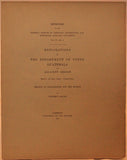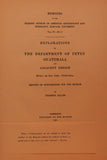Memoirs of the Peabody Museum of American Archaeology and Ethnology, Harvard University Volume IV Number 3: Explorations in the department of Peten Guatemala and Adjacent Region Motul de San Jose; Peten-Itza
Author: Teobert Maler (1842-1917)
Year: 1910
Publisher: Published by Peabody Museum Press
Place: Cambridge
Description:
131-170+[2 plate] pages with diagrams. Folio (14 1/4" x 11 1/4") bond in original publisher's wrappers. Memoirs of the Peabody Museum of American Archaeology and Ethnology, Harvard University, Volume IV Number 3. First edition,
Teobert Maler settled in Yucatán with small house in the town of Ticul, where he set up a photographic studio and learned the Maya language. However he spent most of his time in the forests, accompanied by a few Maya to help clear the jungle from the ruins and carry Maler's photographic equipment. He started off visiting major sites already well-known, such as Chichen Itza and Uxmal, but zealously followed all leads and became the first to document many new ruins. At Chichen, he lived in the ruins for 3 months, and documented the site much more fully than had earlier visitors. Over the next years, Maler also made investigations of many remote sites in the el Petén region of Guatemala and along the course of the Usumacinta River. Maler became disgusted by the then common practice of 19th century antiquarians and archeologists of removing interesting sculptures from the sites to send to cities in Europe or North America. Maler noted the damage to the sites this often caused. He became dedicated to the notion that the ruins should be preserved intact, and wrote extensively to the Mexican government advocating that approach. Maler's views are now considered ahead of their time. Maler realized the importance of publishing his investigations, but had somewhat mixed success. The Peabody Institute of Harvard University arranged to publish his reports starting in 1898. A series of important books resulted, but the relationship between Maler and the Peabody was strained. Maler tried to insist that the books contain more minute detail and illustrations than the Peabody editors wished to include, and communications were difficult as Maler often left to make new expeditions in the forests and could not be contacted for months at a time for proofreading. The Peabody ended their agreement with Maler in 1909, although it took them until 1912 to finish the publication of the material they had received from him. The books are still an important reference in Maya studies. Maler ended his physically demanding expeditions in the jungles in 1905 and retired to his home in Mérida, Yucatán.
Condition:
Light edge wear, corners bumped and rubbed else very good.











